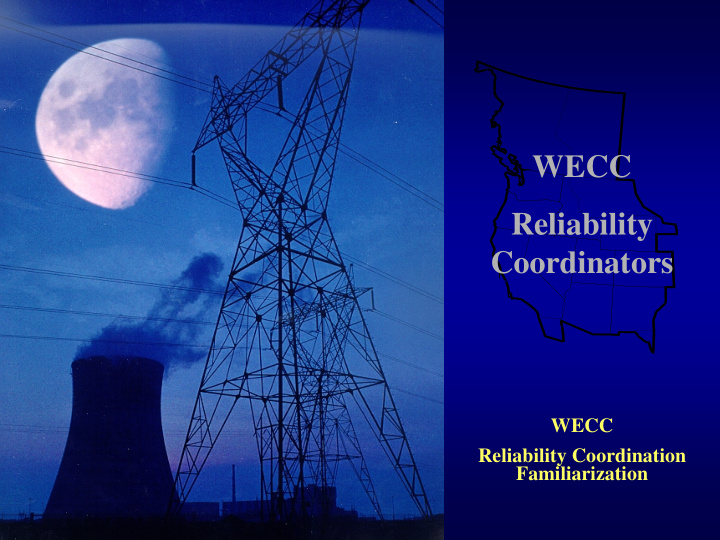



WECC Reliability Coordinators WECC Reliability Coordination Familiarization
Glossary of Terms WECC – Western Electricity Coordinating Council Formed 14 August 1967 WECC continues to be responsible for coordinating and promoting electric system reliability. NERC - Since 1968, the North American Electric Reliability Corporation (NERC) has been committed to ensuring the reliability of the bulk power system in North America. FERC – Federal Energy Regulatory Commission EHV – Extra High Voltage ≥ 345 kV
RELIABILITY COORDINATION January 1994 Eastern I nterconnection experienced significant power outages (including WASHI NGTON DC…) • Extreme COLD weather • I nadequate Energy Resources • I nsufficient Fuel (Deliveries hampered) After-the-Fact investigations revealed: •There were resources available in the Midwest, but… •Frequency was low, but… Not everybody knew Why! I NADEQUATE COMMUNI CATI ON! 1994 - NERC Blue Ribbon Task Force commissioned, which recommended creation of the NERC Security Process Task Force (SPTF). 1996 – NERC SPTF Recommended Creating Regional Reliability Plan for EACH region in NERC!
RELIABILITY COORDINATION Western Interconnection Eastern Interconnection ERCOT
8 NERC Reliability Entities
“WECC” Largest of the 8 NERC Regions (1.8 million square miles) 14 Western states, 2 Canadian provinces, 1 Mexican state (Portion) 153 member systems 33 Control Areas 71 million people • Peak Demand (S) 125,040 MW (W) 114,680 MW • Generation 169,208 MW • Transmission 115,743 Circuit Miles Stats based on 2001 data
35 Balancing Authorities (BAs)
RELIABILITY COORDINATION 1996 – WECC experiences I nterconnection break up! (July 2 and August 10)
RELIABILITY COORDINATION January 1997 WECC Security Process Task Force published the Regional Reliability Plan. •Approved by WECC BOT December 1997, and implemented on January 1, 1998. •Implementation of the WECC EHV Data Pool •Created Regional Reliability Coordinators in each of the three (3) WECC Sub regions CMRC (CI SO) PNSC (BPA) RDRC (WACM) I NDEPENDENCE COMBI NED Rocky Mtn. Rocky Mtn. Desert SW Desert SW The Reliability Coordinator Serves the interest of the Interconnection. MAY 1999 (WAPA) (WAPA) (APS) (APS) Acts in the interests of the overall Interconnection before any other entity (Control Area, etc.).
RELIABILITY COORDINATION TRANSMISSION GENERATION LOAD (Circuit Miles) Three (3) Sub-Regions Pacific Northwest RELIABILITY (PNSC) 36% 54% 45% COORDINATOR AREAS PNSC California/Mexico (CMRC) 38% 23% 33% RDRC Rocky Mountain/Desert Southwest CMRC (RDRC) 23% 22% 26%
WECC EHV Data Pool • VOLTAGE – 500 kV – 345 kV – 230 kV • FREQUENCY – Reliable Sources – Key Points in the System GENERATION • – > 200 MW Voltage Voltage Generation Generation Frequency Frequency
WECC EHV Data Pool KEY TRANSFER PATHS • SCHEDULES FIGURE 2 • ACTUALS EXISTING WSCC KEY TRANSMISSION LINES & PATHS (See WSCC-Wide Key Facility List-Transmission for path description.) • LIMITS 500 KV 345 KV
RELIABILITY COORDINATION Responsibilities (NERC Policy 9; Appendix 9B) - Planning for next-day operations, including reliability analyses and identifying special operating procedures that might be needed. - Analyzing current day operating conditions, - Adequate Resources (RESERVES) - I mplementing I NTERCONNECTI ON-wide relief procedure (TLR- Eastern & USF-WECC), or local procedures to mitigate overloads on the transmission system. -Notification. Interconnection facility status, “Energy Emergency Alert Levels.” -Provide Coordination & Direction during restoration efforts impacting the I nterconnection. Authority to provide emergency assistance. •Each RELIABILITY COORDINATOR must have the authority to take or direct whatever action is needed to mitigate an energy emergency within their Reliability Area. I NDEPENDENCE - STANDARDS OF CONDUCT – CONFI DENTI ALI TY The Reliability Coordinator Serves the interest of Reliability Area and Interconnection. Must act in the interests of the reliability of the overall Reliability Area / Interconnection before any other entity (Control Area, Purchasing-Selling Entity, etc.).
Tools to Monitor the WECC System • WECC EHV Data Pool –10 to 60 second refresh rate • EMS / SCADA Systems –10 second scan rate • WAMS –Wide Area Monitoring System / Phasor Measurement System 0.05 second scan rate • PI Displays & Data Historian (65,000 ICCP) • State Estimator Model (1Min) • Contingency Analysis (5 Min) • Voltage Stability / VAR Management • Real Time Dynamic Stability Analysis
RELIABILITY COORDINATION Operational I nformation Electric System Security Data • Transmission data. • Status • MW or ampere loadings • MVA capability • Transformer tap and phase angle settings • Key voltages • Generator data. • Status • MW and MVAR capability • MW and MVAR net output • Status of automatic voltage control facilities • Operating reserve • CONTROL AREA Demand • Interchange (Scheduled and Actual) • Area Control Error (ACE) and Frequency
Disturbances and Frequency Excursions -1.782
WECC EHV SYSTEM VOLTAGES System Voltage Regional Perspective
Key Transfer Big Picture Operating Perspective Reserves paths
RELIABILITY COORDINATION Conclusion What do Reliability Coordinators do? Monitor & Analyze: • Reliability “Health of the system” • Established NERC & WECC Criteria (Rules) • Evaluate • Predict • and COMMUNICATE.
RELIABILITY COORDINATION Questions
Recommend
More recommend